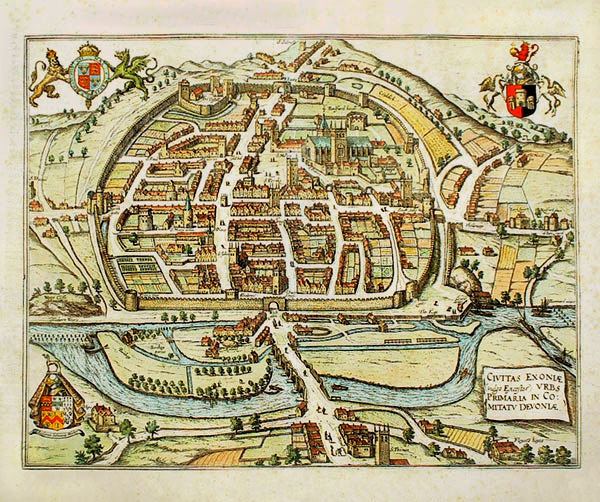Country England Area 18.16 sq mi | Region Mayor Percy Prowse | |
Points of interest Royal Albert Memorial Museum, Crealy Great Adventure Parks, Powderham Castle, St Nicholas Priory - Exeter, Northernhay Gardens Colleges and Universities University of Exeter, Exeter College - Exeter, Exeter College of Art and Design | ||
Exeter is a historic city in Devon, England. It lies within the ceremonial county of Devon, of which it is the county town as well as the home of Devon County Council. Currently the administrative area has the status of a non-metropolitan district and is therefore under the administration of the County Council. The city is on the River Exe about 37 miles (60 km) northeast of Plymouth and 70 miles (110 km) southwest of Bristol. Its population was 117,773 at the time of the UKs 2011 census.
Contents
- Map of Exeter
- Visiting exeter england
- Yokuts sacred place rocky hill exeter california
- Name
- Exeter cuisine
- Real food store exeter
- Newton faulkner professional dog food taster exeter great hall
- Chris ostler exeter food festival play that funky music wild cherry
- References
Map of Exeter
Exeter was the most south-westerly Roman fortified settlement in Britain. Exeter Cathedral, founded in the early 12th century, became Anglican during the 16th-century English Reformation. The modern citys transport hubs include St Davids Railway Station, the Bus and Coach Station, and Exeter International Airport.
Visiting exeter england
Yokuts sacred place rocky hill exeter california
Name
The modern name of Exeter is a development of the Old English Escanceaster, from the anglicised form of the river now known as the Exe and the Old English suffix -ceaster, used to mark important fortresses or fortified towns. (The Welsh name for the city, , similarly means "fortress on the Exe".) The Exe is a separate development of the Brittonic name—meaning "water" or, more exactly, "full of fish" (cf. Welsh pysg, pl. "fish")—that also appears in the English Axe and Esk, the Welsh Usk (Welsh: ), and Scottish whiskey.

Exeter began as settlements on a dry ridge ending in a spur overlooking a navigable river teeming with fish, with fertile land nearby. Although there have been no major prehistoric finds, these advantages suggest the site was occupied early. Coins have been discovered from the Hellenistic kingdoms, suggesting the existence of a settlement trading with the Mediterranean as early as 250 BC. Such early towns had been a feature of pre-Roman Gaul as described by Julius Caesar in his Commentaries and it is possible that they existed in Britannia as well.
The city of Exeter was established on the eastern bank of the River Exe on a ridge of land backed by a steep hill. It is at this point that the Exe, having just been joined by the River Creedy, opens onto a wide flood plain and estuary which results in quite common flooding. Historically this was the lowest bridging point of the River Exe which was tidal and navigable up to the city until the construction of weirs later in its history. This combined with the easily defensible higher ground of the ridge made the current location of the city a natural choice for settlement and trade. In George Olivers The History of the City of Exeter, it is noted that the most likely reasons for the original settling of what would become modern Exeter was the "fertility of the surrounding countryside" and the areas "beautiful and commanding elevation [and] its rapid and navigable river". Its woodland would also have been ideal for natural resources and hunting.
Exeter sits predominantly on sandstone and conglomerate geology, although the structure of the surrounding areas is varied. The topography of the ridge which forms the backbone of the city includes a volcanic plug, on which the Rougemont Castle is situated. The Cathedral is located on the edge of this ridge and is therefore visible for a considerable distance.
The Met Office, the main weather forecasting organisation for the United Kingdom and one of the most significant in the world, relocated from Bracknell in Berkshire to Exeter in early 2004. It is one of the three largest employers in the area (together with the University of Exeter and Devon County Council).
Among the notable buildings in Exeter are:
The Exeter Book, an original manuscript and one of the most important documents in Anglo-Saxon literature, is kept in the vaults of the cathedral. The Exeter Book dates back to the 10th century and is one of four manuscripts that between them contain virtually all the surviving poetry in Old English. It includes most of the more highly regarded shorter poems, some religious pieces, and a series of riddles, a handful of which are famously lewd. Some of the riddles are inscribed on a highly polished steel obelisk in the High Street, placed there on 30 March 2005.

The Exon Domesday (so called from the preservation of the volume at Exeter), is a volume of Domesday Book that contains the full details which the original returns supplied, but only for part of south-west England, i.e. Cornwall, Devon, part of Somerset, part of Dorset and one manor of Wiltshire; it also contains a record of the geld of 1084 for the whole of these counties.
One of Rosemary Sutcliffs best-known childrens books, The Eagle of the Ninth, begins in Roman Isca Dumnoniorum. Lindsey Davis Marcus Didius Falco was stationed with the Second Augusta legion in Isca, and revisits it in The Silver Pigs. The Crowner John Mysteries by Bernard Knight are a series of books set in 12th century Exeter.
Van Helsing, in Bram Stokers Dracula, travels there.
Exeter cuisine
As a predominantly rural county with a temperate climate, frequent rains and fertile soils, Devon has for centuries been a net exporter of high quality dairy produce, fresh fruit and vegetables, meat and fish, particularly after the nineteenth-century expansion in the railway network which enabled the fast transport of fresh goods to the cities. This tradition continues, and many food products, such as premium fish and crab landed in Brixham remain highly regarded, particularly in London.
Real food store exeter
As of 2012, Devon boasts a Michelin Guide two-starred restaurant at Gidleigh Park and three other one-starred establishments. Several high profile restaurant owners have relocated to Devon, to take advantage of its high quality produce, including Damien Hirst, Hugh Fearnley-Whittingstall and Mark Hix with a particular cluster in East Devon around Axminster, Ilfracombe and nearby Lyme Regis on the Dorset border. Another gastronomic cluster in the South Hams centred on Totnes, Dartmouth and Modbury, results from these communities pioneering of the Transition Towns concept to develop a sustainable relationship between producer and consumer in the rural economy, while the historic towns of Tavistock, Okehampton and Widecombe-in-the-Moor remain well known for their ancient seasonal markets.
Newton faulkner professional dog food taster exeter great hall
In October 2008, Devon was awarded Fairtrade County status by the Fairtrade Foundation. A monthly county magazine, Devon Life, regularly publishes articles on the food and drink of the county, and the Cornish & Devon Post, a newspaper published in Launceston, also publishes Cornish & Devon Farming Diary and a yearly eating and entertainment guide, Country Cuisine.
